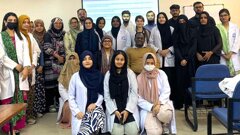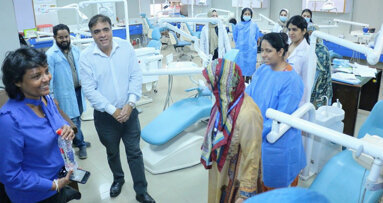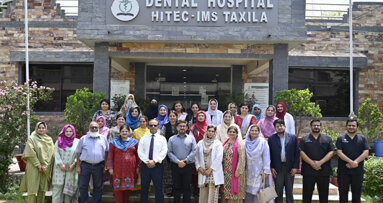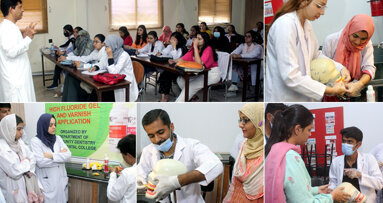Artificial intelligence (AI) is fast becoming a key driver of innovation in dentistry—and now, researchers at UT Health San Antonio and the University of Texas at San Antonio (UTSA) are training machine learning models to predict how dental composites will perform in real-world clinical settings.
This pioneering project, published in the Journal of Dental Research, aims to optimize the selection and development of composite materials used in dental restorations, including fillings, by leveraging AI-driven predictive modeling.
“Very few studies provide the kind of cross-comparable data that machine learning models need,” explained Dr. Kyumin Whang, Barry K. Norling Endowed Professor at UT Health San Antonio.
Despite thousands of academic studies on dental composites, most focus on newly developed or proprietary materials, often evaluated in narrowly defined lab settings. This limits their usefulness for AI, which requires large, standardized datasets for accurate modeling.
Cross-disciplinary collaboration and comprehensive data gathering
The team, co-led by Dr. Yu Shin Kim, associate professor at UT Health San Antonio School of Dentistry, and Dr. Mario Flores, professor of electrical and computer engineering at UTSA, reviewed over 200 scientific publications to compile performance data on 321 commercially available dental composites.
From these, they refined a dataset of 240 composites, including:
- 28 types of additives affecting properties like strength, polishability, and bonding
- 17 measurable performance outcomes, including shrinkage, fracture resistance, and durability
This extensive dataset laid the foundation for AI models capable of recognizing patterns that indicate superior clinical performance.
Toward precision material recommendations with AI
Initial analysis has demonstrated the potential of AI in isolating which material attributes contribute most to long-term success in dental treatments.
“Once we make these models more accurate, we’ll be able to dial in the desired properties, and the AI model would recommend a formulation match,” said Dr. Whang.
This breakthrough could shorten the product development lifecycle, narrowing thousands of possible material combinations to a handful of high-potential options. The result: faster, more efficient design of custom dental composites tailored to clinical needs.
Next step: open-access AI platform for dental material innovation
The researchers envision creating an open-access AI platform where dental manufacturers, clinicians, and research institutions can input formulation data and receive predictive insights into how a material is likely to perform.
Such a tool could:
- Accelerate product development
- Improve clinical outcomes
- Enable data-driven innovation in dental material science
By combining domain expertise from dentistry, biomedical engineering, and AI, this project is setting the stage for a more precise, reliable, and personalized future in restorative dentistry.
KARACHI – Sindh Minister for Health Jam Mehtab Hussain Dahar has said that poor patients must be benefitted with the qualification and experience of ...
By Stephen Luntz
The Centers for Disease Control and Prevention (CDC) have warned the public that the Ebola virus may survive in semen long after it is ...
Live webinar
Mon. 12 January 2026
7:00 pm PKT (Islamabad)
Prof. Judith Jones D.D.S; M.P.H., Prof. Kakuhiro Fukai D.D.S., Ph.D, Dr. Bathsheba (Bethy) Turton
Live webinar
Wed. 14 January 2026
10:00 pm PKT (Islamabad)
Dr. Théo Laplane, Dr. Robert Gottlander DDS
Live webinar
Fri. 16 January 2026
10:00 pm PKT (Islamabad)
Live webinar
Mon. 19 January 2026
11:00 pm PKT (Islamabad)
Philipp Kopp, Michael Seeber
Live webinar
Fri. 23 January 2026
12:00 am PKT (Islamabad)
Dr. Nicola M. Grande DDS, PhD
Live webinar
Wed. 28 January 2026
6:00 pm PKT (Islamabad)
Live webinar
Wed. 28 January 2026
9:00 pm PKT (Islamabad)
Prof. Dr. Jan-Frederik Güth



 Austria / Österreich
Austria / Österreich
 Bosnia and Herzegovina / Босна и Херцеговина
Bosnia and Herzegovina / Босна и Херцеговина
 Bulgaria / България
Bulgaria / България
 Croatia / Hrvatska
Croatia / Hrvatska
 Czech Republic & Slovakia / Česká republika & Slovensko
Czech Republic & Slovakia / Česká republika & Slovensko
 France / France
France / France
 Germany / Deutschland
Germany / Deutschland
 Greece / ΕΛΛΑΔΑ
Greece / ΕΛΛΑΔΑ
 Hungary / Hungary
Hungary / Hungary
 Italy / Italia
Italy / Italia
 Netherlands / Nederland
Netherlands / Nederland
 Nordic / Nordic
Nordic / Nordic
 Poland / Polska
Poland / Polska
 Portugal / Portugal
Portugal / Portugal
 Romania & Moldova / România & Moldova
Romania & Moldova / România & Moldova
 Slovenia / Slovenija
Slovenia / Slovenija
 Serbia & Montenegro / Србија и Црна Гора
Serbia & Montenegro / Србија и Црна Гора
 Spain / España
Spain / España
 Switzerland / Schweiz
Switzerland / Schweiz
 Turkey / Türkiye
Turkey / Türkiye
 UK & Ireland / UK & Ireland
UK & Ireland / UK & Ireland
 International / International
International / International
 Brazil / Brasil
Brazil / Brasil
 Canada / Canada
Canada / Canada
 Latin America / Latinoamérica
Latin America / Latinoamérica
 USA / USA
USA / USA
 China / 中国
China / 中国
 India / भारत गणराज्य
India / भारत गणराज्य
 Vietnam / Việt Nam
Vietnam / Việt Nam
 ASEAN / ASEAN
ASEAN / ASEAN
 Israel / מְדִינַת יִשְׂרָאֵל
Israel / מְדִינַת יִשְׂרָאֵל
 Algeria, Morocco & Tunisia / الجزائر والمغرب وتونس
Algeria, Morocco & Tunisia / الجزائر والمغرب وتونس
 Middle East / Middle East
Middle East / Middle East





























































To post a reply please login or register